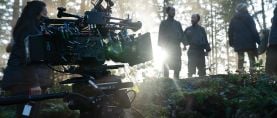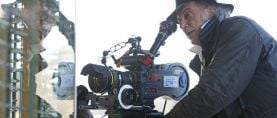
MITC Meeting Report: August 2018
On August 29, the ASC Motion Imaging Technology Council (MITC) met at the ASC Clubhouse.
On the evening of August 29, the ASC Motion Imaging Technology Council (MITC) met at the ASC Clubhouse. Despite the proximity to the Labor Day weekend, the room was packed and the energy level was high, ideal for the evening’s full agenda.
MITC chair Chair Curtis Clark, ASC called the meeting to order, and, after a handful of guests were introduced, asked for feedback on recent events, including Anamorphic Lens Day, The Reel Thing, SIGGRAPH and the International Cinematography Summit.
Thanks went to Lens Committee co-chair Jay Holben for orchestrating the Anamorphic Lens Day, held on August 18 at the Clubhouse, which was dubbed a success. Lenny Lipton described the early color systems (Kinemacolor and Dunning color) shown at The Reel Thing event held at the AMPAS Pickford Center on August 23-25, and the highlight at SIGGRAPH, held on August 12-16 in Vancouver, was Nvidia’s new GPU processors for real-time ray tracing. The International Cinematography Summit, covered in American Cinematographer and online, was described as well-attended and successful.
In a roundup of reports and updates, ACES Project vice-chair Joachim “JZ” Zell said that this group, chaired by Annie Chang and including vice-chair Rod Bogart, published the results of an ACES listening tour, including interviews with cinematographers, on ACESCentral.com. Thomas Wall described the progress status of collecting HDR image reference materials, reporting that G-Technology donated a 24TB G-RAID. With the involvement of the Next Generation Cinema Display Committee, Roundabout graded the HDR material on a Sony BVM-X300 4K OLED monitor and Samsung Onyx LED cinema screen. Wall emphasized that the image reference material is for public use/display only with explicit permission of the ASC.
The MITC committees then made their reports, beginning with the Lens Committee, co- chaired by Holben and Michael McDonough, ASC, BSC. Holben reported that Lens Committee vice-chair Christopher Probst, ASC has joined the project to create a comprehensive CineLens database. So far, they have catalogued 3,000 lenses and promised that the database will eventually be presented via the ASC website. The committee has also collaborated with Cooke and Zeiss to run tests of extended metadata, which would allow VFX artists to skip mapping in favor of comprehensive lens data. “Zeiss was the first to implement this,” said Holben, who reported that, at CineGear, the committee presented footage of a green screen shot with a rack focus that was re- composited via metadata. “A lot of camera manufacturers say they can do it, but it’s not a priority,” said Holben. “Now is the time to get VFX companies to be aware of the technology and start asking for it. As soon as we start hollering for it, we can get it implemented and simplify the process.”
The Lens Committee also has created two new subcommittees, both chaired by ASC associate member Matt Duclos: one on diffusion filter classification, to give cinematographers more information on how to select diffusion filters, and a second on focus accuracy, as proposed by ASC associate member Howard Preston. “As camera image sensors become larger to accommodate Large Format imaging with less depth of field, markers become more important for lenses,” said Holben. “We’re looking to see if we can make recommendations.”
For the Next Generation Cinema Display Committee, co-chaired by Eric Rodli and Joachim Zell (“JZ”), committee member Michael Karagosian described gathering HDR material, with the help of Thomas Wall, and how the committee believes that a best next step would be to create a new version of the 2004 ASC Technology Committee-produced StEM material, created in collaboration with the Digital Cinema Initiative LLC. “That would be an exciting step,” Karagosian said, adding that the UHDTV Committee should also be involved. “This would not be our committee’s project, alone, but rather an ASC MITC project.”
Pete Ludé reported on DCI progress on Direct View (LED) Cinema displays, summarizing the process of creating new specifications. “Security, consistency of the image seamless interoperability and high quality image and sound are the motivation,” he said, adding that, “emissive displays could enable HDR imaging.”
“Following DCI procedures, the Digital Cinema Systems Specification would address emissive displays and, after DCSS updates, our Compliance Test Plan will also be amended as appropriate,” Ludé added. He also described image quality, with regard to peak luminance, minimum active black level, color gamut and accuracy, gray scale tracking, screen surface reflectivity, high frame rate and scaling. Those interested in being part of the conversation were invited to contact him at [email protected]
Reporting on the UHDTV Committee, co-chairs Don Eklund and Bill Mandel described how committee members Annie Chang, who is also ACES Project chair, and Mike Zink are still compiling the responses to the UHD Alliance survey they sent to the ASC via MITC requesting input on how ASC cinematographers and the filmmaking community feel about the performance of UHD HDR enabled consumer displays and the importance of establishing agreement among display vendors for common calibration settings that accurately reproduce filmmaker creative intent. Eklund reported positive responses from several computer graphics display manufacturers to produce monitors for high-quality VFX. “The monitors available to VFX businesses haven’t changed in 10 years, and that’s obviously problematic when consumer TVs have advanced so much,” Eklund said. “The work is ultimately seen in HDR, but the VFX artist creating it doesn’t see it in HDR.” The specs, he continued, should be “something around 1,000 nits, full P3 color gamut coverage and calibrate-able, but at a realistic price point, necessary for a big VFX house that might need to buy 500 monitors.”
Eklund says he is continuing to work on a test pattern for testing and monitor evaluations that could be read by a layperson and distributed license-free. He also brought up the topic of ambient light, which “the consumer industry hasn’t addressed at all.”
“There are no standards on this, and it’s an area ripe for study,” Edklund continued. “I would love to engage with some experts in the room to develop recommendations.” Mandel suggested a visit to www.Hgig.com, an HDR gaming interest group’s site.
Gary Demos, who chairs the Advanced Imaging Committee with vice-chairs Jim Fancher, Bill Mandel, Joe Kane and David Reisner, introduced his guest, CalTech principal electronics engineer Roger Smith, who gave a presentation on the Zwicky Transient Facility (ZTF), a very high-resolution, wide-field telescope. He showed slides of what CalTech scientists are able to see with the ZTF, and how it will complement the Large Synoptic Survey Telescope (LSST) being built in Chile.
Greg Ciaccio, who chairs the Motion Imaging Workflow Committee with vice-chairs Tim Kang and George Joblove and Joseph Goldstone, introduced Jesse Korosi, Sim director of workflow services, who will head up a new subcommittee, on advanced data management. Korosi then gave the second presentation of the evening, describing all the problems that can arise as data and metadata go through a typical workflow on set. “It’s a chain of custody issue, and standardization would help,” Korosi concluded, noting that Sim relies on Metabanq, which aggregates metadata, as the hub for the distribution of files. “Lots of departments can benefit from data sharing, which requires standardization.”
Korosi noted that there’s also “the giant topic of computer vision data. As a subcommittee, we need to figure out where we want to start and stop and how broadly we should be looking at this.” He suggested that anyone interested in being involved should contact him at [email protected]
Tim Kang is interested in starting a group to look into solid-state lighting, to promote a better of understanding of the impact of these lights on sets and in post workflows. “The nuances to understand it aren’t there,” he said, adding that he is working with the Academy’s Sci-Tech Council on the topic. “There has to be an educational effort to organize LED lighting tests.” A Lighting Subcommittee has been established under Motion Imaging Workflow, with Kang as chair.
Coordinator W. Thomas Wall delivered the SSIMWave Evaluation Group report, noting that, thanks to contacts at Lenovo, Liquid and Blackmagic Design, he has been able to put together a testing system. “We now have the hardware and software to put together to do testing for our evaluation of HDR,” Wall said. “We’ve made arrangements with the ASC to come up with digital storage requirements. We’re hoping to have a working system to demonstrate in a little over a month and, in November, we’ll begin our study.”
Finally, via videoconference from Vancouver, David Morin and Michael Goi, ASC, who head up, with Mike Sanders, the Joint Technology Subcommittee on Virtual Reality, gave an update on VR, noting that their next meeting was the following week, on Sept. 5 at Stargate Studios, where Sam Nicholson, ASC would demonstrate applications of VR for production, including LED walls for green screen replacement. Goi is currently working on 360-degree video project. “What we’re in the process of doing now is a shot that I can work with for more precise camera placement while I’m on location, and then put that in the storyboard/previs,” Goi said.
Both noted that SIGGRAPH hosted several presentations related to virtual production. The two also described the Academy Software Foundation (https://www.aswf.io/), launched at SIGGRAPH in a keynote by Rob Bredow — SVP, Executive Creative Director and Head of Industrial Light & Magic — that grew out of an Academy survey on open-source software. “As OSS libraries grew, it became difficult to coordinate software components,” said Morin. “OSS development and licensing are challenging. The Academy Software Foundation is a neutral forum for OSS developers in the motion picture industry. The goal is to coordinate cross-platform efforts, establish best practices and share resources, as well as develop an open continuous integration and build infrastructure.”
After the conclusion of the committee reports, the meeting turned to describing upcoming events including Burning Man (August 26-September 3, attended annually by Josh Pines), IBC (September 13-18 in Amsterdam) and the Display Summit (October 2-3, Northridge, CA), and adjourned.
The next MITC meeting will take place in November.





